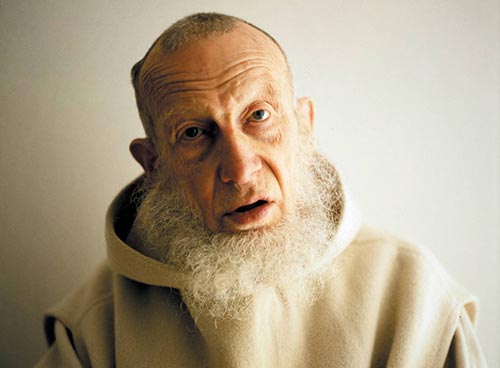Heads, feet, and hair seem to be essential to much religious practice.
In the place of worship – Christian males: head uncovered, feet covered; Jewish males: head covered, feet covered; Muslim males: head covered, feet uncovered.
Sikh: hair never cut. Buddhist monks and nuns: head fully shaved. Jewish (First Testament/Hebrew Bible) regulations about not cutting hair; Eastern Orthodox clergy beards and long hair; debates throughout Christian history about the shape of the monastic tonsure (the shaving of the head); Western regulations about priests not sporting facial hair; some orders of sisters remove some hair;…
I recently saw a comment to the above photo, noting the beard but no moustache. The comment was that this was common in monasteries in the medieval period, and it went on to state that this was out of reverence so that no consecrated wine might become attached to the moustache.
What further interests me, then, if this theory has credence, is that the above photo is the traditional beard for Carthusian brothers. The brothers can grow beards (but without the moustache), but the priests, or those to be so, could not. Looking around further, another post suggests, “The choir monks [priests or to be priests] remain clean shaven out of respect for Mass the reception of the Wine during Eucharist.” If it is the brothers who shave off the moustache out of reverence for the consecrated wine, does this go back to a time when brothers as well as priests received this at Mass?
I cannot recall any discussion ever about consecrated wine and moustaches. If this has been discussed, do point me to it.
postscript
I like the saying, “The habit doesn’t make the monk”. One might apply this to hair…
There is also a Yiddish proverb, “Better a Jew with no beard than a beard with no Jew.”
image from Into Great Silence




When I first saw your post, I thought of something entirely different. I might have grown up as a Lutheran: a family legend says that my great-grandmother was grossed out by men with handlebar mustaches drinking from the common cup. The family moved to the Congregational Church that used little cups of grape juice. Another thought: beards without mustaches is common in the U.S. among Amish and Mennonite men, I think.
Thanks, Gloria. Yes, I wonder about the Amish, Mennonite, Monastic, Medieval connection. Blessings.
From what I’ve read, the Anabaptist pattern of beard without mustache comes from the association of mustaches with the military.
Orthodox priests are required to keep their moustaches short to keep it out of the chalice.
Over generalisation about Christians. Some (Copts, Ethiopians) feet uncovered, and sometimes head covered.
I don’t have the details here but medieval Cistercians wrote treatises ‘On beards’; De barbis. I have only seen them in the Patrologia Latina, never translated.
Thanks, Stephen! Following your lead, I did find this. Blessings.